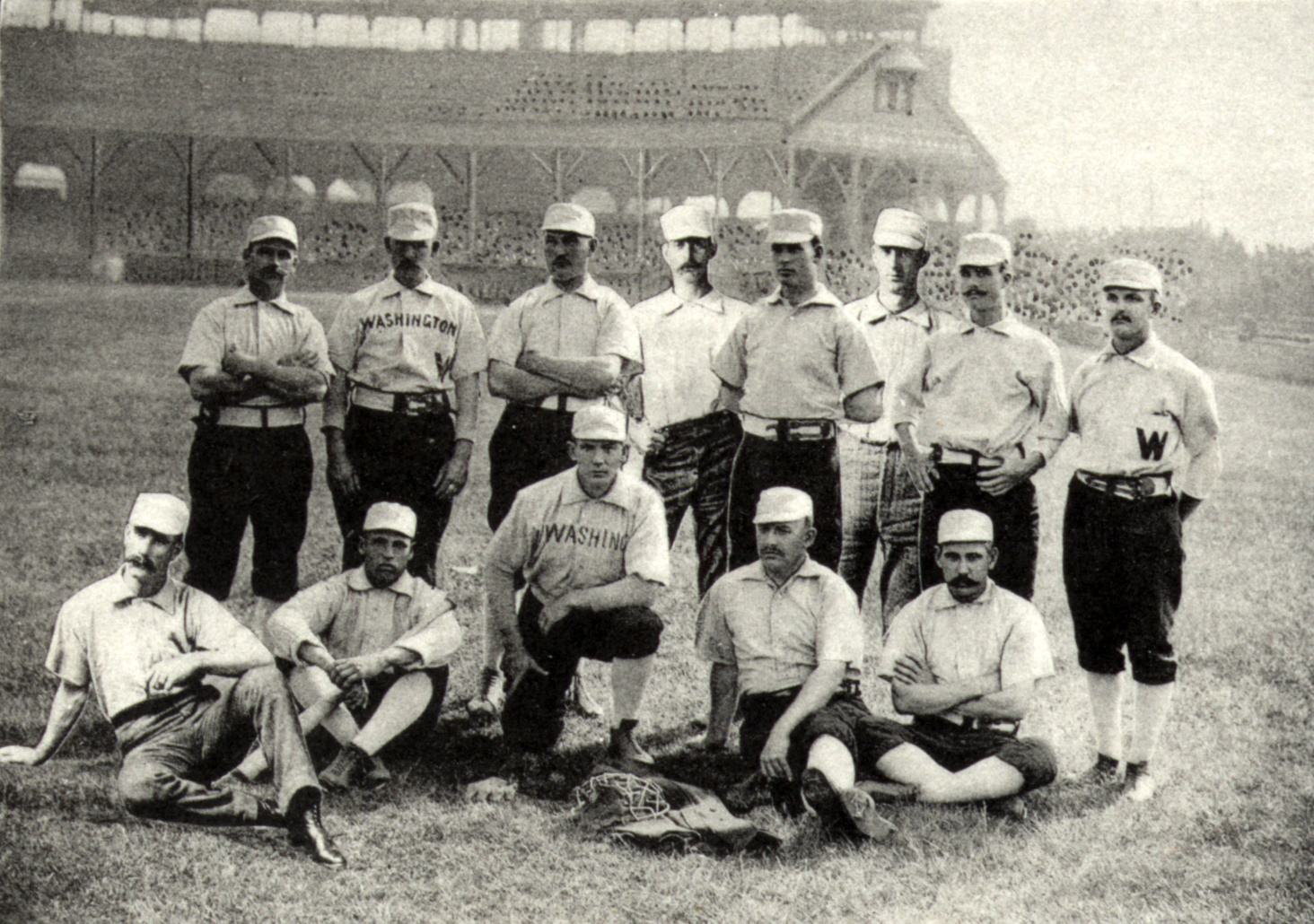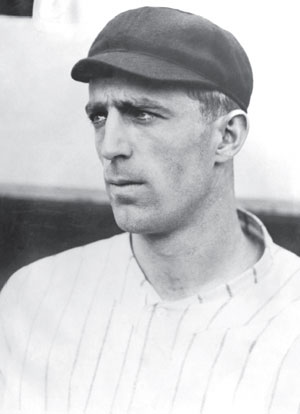|
Baseball's Sad Lexicon
"Baseball's Sad Lexicon," also known as "Tinker to Evers to Chance" after its refrain, is a 1910 baseball poem by Franklin Pierce Adams. The eight-line poem is presented as a single, rueful stanza from the point of view of a New York Giants fan watching the Chicago Cubs infield of shortstop Joe Tinker, second baseman Johnny Evers, and first baseman Frank Chance complete a double play. These three players helped the Cubs win four National League championships and two World Series from 1906 to 1910. "Baseball's Sad Lexicon" became popular across the United States among sportswriters, who wrote their own verses along the same vein. The poem only enhanced the reputations of Tinker, Evers, and Chance over the succeeding decades as the phrase became synonymous with a feat of smooth and ruthless efficiency. It has been credited with their elections to the National Baseball Hall of Fame in 1946. Publication The poem was first published in the ''New York Evening Mail'' on July 12, 1 ... [...More Info...] [...Related Items...] OR: [Wikipedia] [Google] [Baidu] |
Joe Tinker
Joseph Bert Tinker (July 27, 1880 – July 27, 1948) was an American professional baseball player and manager. He played from 1902 through 1916 for the Chicago Cubs and Cincinnati Reds of Major League Baseball (MLB) and the Chicago Whales of the Federal League. Born in Muscotah, Kansas, Tinker began playing semi-professional baseball in Kansas in the late 19th century. He began his professional career in 1900 in minor league baseball and made his MLB debut with the Cubs in 1902. Tinker was a member of the Chicago Cubs dynasty that won four pennants and two World Series championships between 1906 and 1910. After playing one season with Cincinnati in 1913, he became one of the first stars to jump to the upstart Federal League in 1914. After leading the Whales to the pennant in 1915, he returned to the Cubs as their player-manager in 1916, his final season in MLB. Tinker returned to minor league baseball as a part-owner and manager for the Columbus Senators before moving to Orlan ... [...More Info...] [...Related Items...] OR: [Wikipedia] [Google] [Baidu] |
Gonfalon
The gonfalon, gonfanon, gonfalone (from the early Italian language, Italian ''confalone'') is a type of heraldic flag or banner, often pointed, swallow-tailed, or with several streamers, and suspended from a crossbar in an identical manner to the ancient Roman vexillum. It was first adopted by Italian medieval communes, and later, by local guilds, corporations and districts. The difference between a gonfalon with long tails and a standard is that a gonfalon displays the device on the non-tailed area, and the standard displays badges down the whole length of the flag. Background A gonfalon can include a badge or coat of arms, or decoration. Today, every Italian comune (municipality) has a gonfalon sporting its coat of arms. The gonfalon has long been used for ecclesiastical ceremonies and processions. The papal "ombrellino", a symbol of the pope, is often mistakenly called "gonfalone" by the Italians because the pope's ceremonial umbrella was often depicted on the banner. ''Gonf ... [...More Info...] [...Related Items...] OR: [Wikipedia] [Google] [Baidu] |
Hank O'Day
Henry M. O'Day (July 8, 1859 – July 2, 1935), nicknamed "The Reverend", was an American right-handed pitcher and later an umpire and manager in Major League Baseball. After a seven-year major league playing career, he worked as a National League (NL) umpire for 30 seasons between 1895 and 1927. O'Day umpired in ten World Series – second only to Bill Klem's total of 18 – including five of the first seven played, and was behind the plate for the first modern World Series game in 1903. Retiring at age 68 years, 2 months, he remains the oldest umpire in major league history – a fact which was not known until recently, as he routinely shaved five to seven years from his true age throughout his career. His 3,986 total games as an umpire ranked third in major league history when he retired, and his 2,710 games as the plate umpire still rank second in major league history to Klem's total of 3,544. He is largely known for his controversial decision in a pivotal ... [...More Info...] [...Related Items...] OR: [Wikipedia] [Google] [Baidu] |
Umpire (baseball)
In baseball, the umpire is the person charged with referee, officiating the game, including beginning and ending the game, enforcing the rules of the game and the grounds, making judgment calls on plays, and handling the disciplinary actions. The term is often shortened to the colloquial form ump. They are also sometimes addressed as blue at lower levels due to the common color of the uniform worn by umpires. In professional baseball, the term ''blue'' is seldom used by players or managers, who instead call the umpire by name. Although games were often officiated by a sole umpire in the formative years of the sport, since the turn of the 20th century, officiating has been commonly divided among several umpires, who form the umpiring crew. The position is analogous to that of a referee in many other sports. Duties and positions In a game officiated by two or more umpires, the umpire in chief (usually the home plate umpire) is the umpire who is in charge of the entire game. This um ... [...More Info...] [...Related Items...] OR: [Wikipedia] [Google] [Baidu] |
Christy Mathewson
Christopher Mathewson (August 12, 1880 – October 7, 1925), nicknamed "Big Six", "the Christian Gentleman", "Matty", and "the Gentleman's Hurler", was a Major League Baseball right-handed pitcher, who played 17 seasons with the New York Giants. He stood tall and weighed . He was among the most dominant pitchers in baseball history, and ranks in the all-time top 10 in several key pitching categories, including wins, shutouts, and earned run average. In 1936, Mathewson was elected into the Baseball Hall of Fame as one of its first five members. Mathewson grew up in Factoryville, Pennsylvania, and began playing semiprofessional baseball when he was 14 years old. He played in the minor leagues in 1899, recording a record of 21 wins and two losses. He pitched for the New York Giants the next season, but was sent back to the minors. He eventually returned to the Giants, and went on to win a National League record 373 career games, tied Grover Cleveland Alexander for the third m ... [...More Info...] [...Related Items...] OR: [Wikipedia] [Google] [Baidu] |
Merkle's Boner
Merkle's Boner refers to the notorious base-running mistake committed by rookie Fred Merkle of the New York Giants in a game against the Chicago Cubs on September 23, 1908. Merkle's failure to advance to second base on what should have been a game-winning hit led instead to a force play at second and a tied game. The Cubs later won the makeup game, which proved decisive as they beat the Giants by one game to win the National League (NL) pennant for 1908. It has been described as "the most controversial game in baseball history". Background The NL pennant race of 1908 was a three-way fight among the teams that dominated the league in the first decade of the modern era: the Pittsburgh Pirates (pennant winners in 1901, 1902, and 1903), the Giants (winners in 1904 and 1905), and the Cubs (winners in 1906 and 1907). The teams were clustered in the standings all year, with Pittsburgh never more than 2.5 games ahead or 5 games behind, the Giants never more than 4.5 ahead or 6.5 behi ... [...More Info...] [...Related Items...] OR: [Wikipedia] [Google] [Baidu] |
Bobby Lowe
Robert Lincoln Lowe (July 10, 1865 – December 8, 1951), nicknamed "Link", was an American Major League Baseball (MLB) player, coach, and scout. He played for the Boston Beaneaters (1890–1901), Chicago Cubs (1902–1903), Pittsburgh Pirates (1904), and Detroit Tigers (1904–1907). Lowe was the first player in Major League history to hit four home runs in a game, a feat which he accomplished in May 1894. He also tied or set Major League records with 17 total bases in a single game and six hits in a single game. Lowe was a versatile player who played at every position but was principally a second baseman. When he retired in 1907, his career fielding average of .953 at second base was the highest in Major League history. Lowe also worked as a baseball manager, coach, and scout. He was the player-manager of the Detroit Tigers during the last half of the 1904 season. He was also a player-manager for the Grand Rapids Wolverines in 1908, and coached college baseball ... [...More Info...] [...Related Items...] OR: [Wikipedia] [Google] [Baidu] |
Barry McCormick
William Joseph "Barry" McCormick (December 25, 1874January 28, 1956) was a professional baseball player and later a Major League umpire. As a player, he played infielder in Major League Baseball from 1895 to 1904. He would play for the Louisville Colonels, Chicago Colts/Orphans, St. Louis Browns, and Washington Senators. McCormick was the last player to have eight at-bats in a nine-inning game, achieving this feat on the 29th of June, 1897. After retiring as a player, he took up umpiring, making his Major League debut in 1917 and winding up his second career in 1929. He was behind the plate for the longest extra inning game in Major League history, the 26-inning contest between the Brooklyn Dodgers and Boston Braves on May 1, 1920. See also *List of Major League Baseball single-game hits leaders In baseball, a hit is credited to a batter when he reaches first base – or any subsequent base – safely after hitting a fair ball, without the benefit of an error or a field ... [...More Info...] [...Related Items...] OR: [Wikipedia] [Google] [Baidu] |
Third Baseman
A third baseman, abbreviated 3B, is the player in baseball or softball whose responsibility is to defend the area nearest to third base — the third of four bases a baserunner must touch in succession to score a run. In the scoring system used to record defensive plays, the third baseman is assigned the number 5. Third base is known as the "hot corner", because the third baseman is often the infielder who stands closest to the batter—roughly 90–120 feet away, but even closer if a bunt is expected. Most right-handed hitters tend to hit the ball hard in this direction. A third baseman must possess good hand-eye coordination and quick reactions to catch batted balls whose speed can exceed . The third base position requires a strong and accurate arm, as the third baseman often makes long throws to first base or quick ones to second base to start a double play. As with middle infielders, right-handed throwing players are standard at the position because they do not need to ... [...More Info...] [...Related Items...] OR: [Wikipedia] [Google] [Baidu] |

.jpg)




